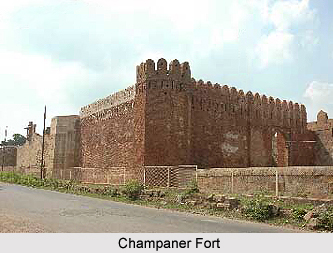 Champaner Fort is one of the most distinguished forts of 16th century. This fort is one of archeological heritage site, stands out as an exemplary historical monument in Gujarat. This is famous for its interesting architecture. As Champaner was a strategic center, the hill was heavily fortified wherein the fortification grew downwards with layers of fortification.
Champaner Fort is one of the most distinguished forts of 16th century. This fort is one of archeological heritage site, stands out as an exemplary historical monument in Gujarat. This is famous for its interesting architecture. As Champaner was a strategic center, the hill was heavily fortified wherein the fortification grew downwards with layers of fortification.
The walls and the gates of the surroundings of Champaner Fort dates back to 13th century. The first fortification of Champaner Fort is entered through the Atak gate. The Atak Gate has two gateways and catapult structures stalled to throw stones at enemy. The western end has the Budhiya gate, with three gateways. The Machi Gate has four successive gates joined by huge battlements; of these the Moti or Sadan Shah Gate is the most important, cut through solid rock.
Champaner Fort better known as Muhammadabad Fort is a city filled up with the historical interests in the state of Gujarat. It is located in Panch Mahal district which is 47 kilometers from the city of Vadodara. Champaner Fort was founded by Vanraj Chavda. He was the most prominent king of the Chavda Dynasty, in the 8th century AD. Chavda Dynasty was an ancient Hindu Kshatriya dynasty which ruled northern part of Gujarat from 746 to 942. He named the fort, the Champaner Fort, after the name of his friend and general Champa. Later this was known later as Champaraj.
By the later 15th Century, the Khichi Chauhan Rajputs held Pavagadh fort above the town of Champaner. The young Sultan of Gujarat, Mahmud Begada, deciding to attack Champaner, started towards it with his army on 4 December 1482. After defeating the Champaner army, Mahmud captured the town and besieged Pavagadh. The Pavagadh was the well-known hill-fortress, above Champaner, where King Jaya Simgha had taken refuge. He captured the Pavagadh fort on 21 November 1484, after a long and tough battle after twenty days. He then spent 23 years in rebuilding and embellishing Champaner Fort and the whole Champaner Fort town, which he renamed Muhammadabad. Later he moved the capital there from Ahmedabad. In 1535, after chasing away Bahadur Shah, Humayun, one of the greatest Mughal Emperors in India personally lead some 300 Mughal armies to scale the fort on spikes driven into rock and stonework in a remote and unguarded part of the citadel built over a precipitous hillside on Pavagadh Hill. A large heap of gold, silver and jewels were the war booty even though Bahadur Shah had managed to escape with a lot to Diu. Champaner Fort is now one of the most important heritage sites called Champaner-Pavagadh Archaeological Park. The United Nations Educational, Scientific and Cultural Organization (UNESCO) has designated Champaner and the Champaner Fort as a World Heritage Site in the year 2004. Now this place is famous in Gujarat for Monuments of Champaner.



















